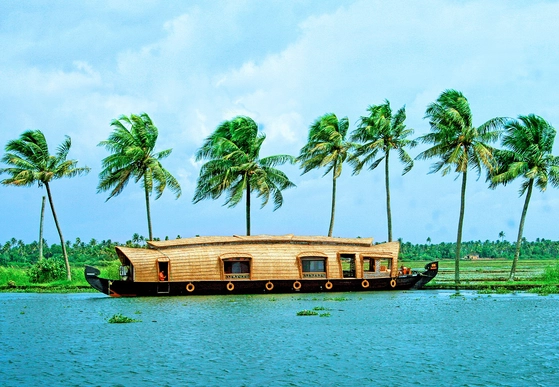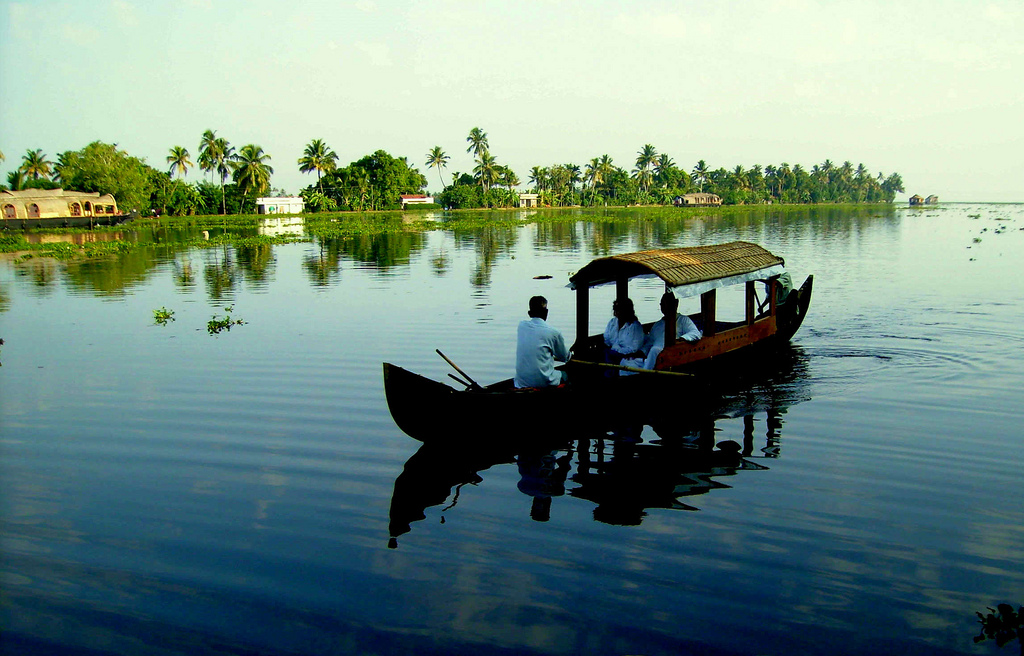Kerala Boat House History
History of Houseboats
During the ancient times, the Kettuvallam was instrumental in economic development – transporting men and cargo from everywhere across the waters, the remote places which were not otherwise accessible. These boats, which are around 100 feet long, were mostly used to transport spices, rice and other kinds of goods. Interestingly the magnificent structure and size of Kettuvallam is three times more than a normal cargo truck! That is, the houseboat can carry more than 25 tons which is equivalent to what three huge trucks can carry. Amazing, right? That is why in olden days, this was the most preferred transport option to carry heavy loads and also take people to remotest of villages via backwaters. Moreover, the other means of transportation like rail and road ways were either expensive or not developed in those days.
The houseboat offered good provision for the boatmen in terms of cooking food and sleeping purpose and also, ample space for their families to accompany them on longer journeys. People of royal hierarchy found a comfortable advantage of living in these floating houses while travelling to different places. However with the coming of modernization, houseboat took a backseat while other means of transportation got rapidly developed and were used more. Eventually, the Kerala houseboats were merely left for promoting tourism and, what was once a humble transport option turned out to be a means of luxury and relaxation.

Kerala Boat House History
Truly enough these houseboats have been highly influential in boosting the travel and tourism industry of Kerala. Thanks to Kettuvallam, the God’s Own Country has become a hub of tourism and most favourite destination for holiday and rejuvenation. Travelling in a houseboat will make you feel that time has come to a standstill.
One would find it quite fascinating and exciting to take a trip down the lovely backwaters in the kettuvallam. While sailing down slowly, you can simply sit in the comforts of your bedroom or on the deck and enjoy the scenery passing by – watching the lush green banks, the blue waters below, occasionally waving children on the banks of the villages and taking a deep breath of fresh air.
Nowadays it has become mandatory to infuse eco-friendly elements within the mechanism of one’s lifestyle that includes the mode of transportation. Thereby making a houseboat in Kerala one of the most environmental friendly, non-polluting and economical travel options. So relevant steps are being taken to promote and develop these kinds of boats. Owning to the high demands of tourists, these old fashioned kettuvallams are back in vogue with a modern twist. They have given a redefined meaning for leisure, tranquillity and trip down the historical locales of Kerala.
Basic Structure of Kettuvallam/Houseboat
The hull of the traditional houseboat is made up of a series of wooden planks, cut lengthwise and carved by highly skilled carpenters and tied together using coir, secured firmly by stuffing coconut fibres in between. Surprisingly while building this entire structure, not even a single nail is being used.
Initially, two people – a chief oarsman and an assistant – used to steer the houseboat the help of long bamboo poles called as Kazhukol in local language. While these were used to guide the houseboat in shallow areas, there are bamboo beams attached on the sides which doubles up as footholds.
The cooking area is usually located in the lower racks while storage facilities and living quarters are on the upper and topmost racks respectively. In the absences of any cargo, the interior area can be used for similar purposes. Food and other essential items are stored separately in shelves whereas earthenware vessels are used to store fresh water.

The main top frame of houseboat is in yellowish-brown colour, which is in fact the natural colour of materials such as coir/panambu and bamboo. Comparing to the surrounding colours around the houseboat, this colour is of warmer tone which gives a pleasant feeling while being inside the boat. The framework of roof is built using bamboo while splits of bamboo are used to weave mats for roofing.
The kettuvallam that we come across today is far different and has been transformed completely from what it was earlier. In order to make one’s stay within the Kerala houseboat, some changes within its body was brought in to avoid inconvenience and problems. The body was completely remodelled and redesigned to match new-age demands and utilities. In order to make sufficient space with the bedroom, it became necessary to increase the height of the roof. And to avoid the shortcomings of the hull’s curved shape, a plank was strategically laid through the entire length so that it could be used for comfortable seating and walking effortlessly. Ample light, view and airflow was offered through windows and other types of openings. At the centre of linear axis with a panel hung at the top, an entrance was created.
The modern day Kettuvallam are build using sophisticated designs and coming in one-bedroom, two-bedroom and triple rooms houseboat, Four bed room houseboats, even as far as five/six-bedroom houseboats. In fact there is also an option for opting Family Houseboats which includes living area, modern toilet facility and kitchen. To fix toilet seats, ceramic floor and shower tray, a concrete slab is laid across at the floor level. The toilets are specially designed using steel cabinets with steel meshes that promotes a special variety of bacteria which feeds on human waste. This in turn gets break down into safe, odourless soil kind of substance that is let out into the water below, helping the backwaters and environment free from getting polluted. The water is stored in a tank on top of the main boat body that is connected to bathrooms and kitchen. Coir or panambu is used to cover the tank, pipes and other plastic materials in order to keep up the aesthetic essence of eco-friendly resources. The boats are fitted with air cylinders on the either side of the frames of entrance in order to balance the entire structure on the waters so as to reduce and avoid tilting of the boat on sides.
The contemporary Kettuvallam has been designed to be on par with the Gold Star/Green Palm Certifications issued by the Department of Tourism, Government of Kerala. This has been made mandatory quite recently as a means to meet the quality standards maintained by Kerala Tourism House Boats. Now Houseboat Operators are selling their boat as deluxe ac Houseboat & Premium / Luxury Houseboats.
The modern kettuvallam or Kerala house boat in Kerala boasts of having plush interiors. However the owners are keen to retain the old, traditional look and so try to incorporate the very elements within the modern style. The furniture is mostly of wood or cane, with flooring done using wooden panels and coir mat. All the colours of these elements are chosen to be in sync with the beautiful scenery offered by the surroundings, around the houseboat.
These days, houseboats make use of different kinds of lighting to keep up the luxurious effect and feel of living spaces. A traditional hurricane lamp is used during nights to light up the interiors – one, in the front at the entrance and another at the rear of the houseboat. Most of the nights, the moon acts as providing natural light, that gets reflected from water as well, making a picture-perfect setting. These days, Kerala houseboats are well-equipped with generators or supported by solar power for power and lighting purposes inside.
Coco Houseboats Alleppey, Kerala maintains toilets that are eco-friendly, tested as well as certified by Central Research Laboratory (CRL), which are specifically attached to gather the wastes so as to avoid polluting the Alleppey backwaters.
